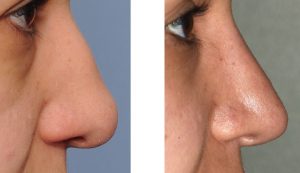Rhinoplasty can make significant changes to the appearance of the nose whether it is the removal of a bump from the bridge or a narrowing and lifting of the tip. No matter what structural reshaping of the nose has been done, its aesthetic improvements can only be perceived by how the skin overlies it. Often overlooked, the skin should not be ignored as an important contributor to the final effects of a rhinoplasty procedure.
Regardless of how the bone and cartilage of the nose has been reshaped, these changes require the overlying skin to shrink and adapt down to the newly altered framework. In essence the effects of a rhinoplasty is highly influenced by the size and thickness of the enveloping skin. It is well known that thinner skinned patients gets less nasal swelling after rhinoplasty, show the results sooner and is more likely to show any irregularities or asymmetry caused by the surgery. Thin-skinned patients show more refined rhinoplasty results. Conversely, thick-skinned patients get a lot of nasal swelling, takes a long time for it to settle down and masks framework imperfections better.
Compared to the bone and cartilages that make up the sides of the nose, the overlying skin actually occupies a larger surface area. It can not be manipulated or removed so it is not a variable that can be changed by surgery. It is really a fixed variable in rhinoplasty even though it is usually perceived as a variable one. While widely believed that skin has a great ability to shrink, it really has a limited ability to do so. The perception of skin shrinking after rhinoplasty is probably more that of the swelling going away rather than less skin resulting afterward.

The skin of the nose must be respected in a rhinoplasty. Large thick-skinned noses must not have too much structural support removed underneath it, particularly in the tip area. Otherwise a contracted unshapely tip appearance may result that can be uncorrectable later. Rhinoplasty should be done with an appreciation for the volume of the overlying skin and where it is least likely to adapt well.
The size and thickness of the skin of the nose should also temper a patient’s expectations. Too much can be expected in thick-skinned rhinoplasty patients when more subtle changes are realistic.
Dr. Barry Eppley
Indianapolis, Indiana


